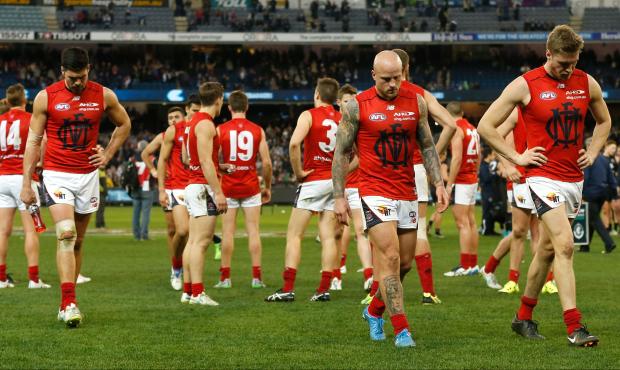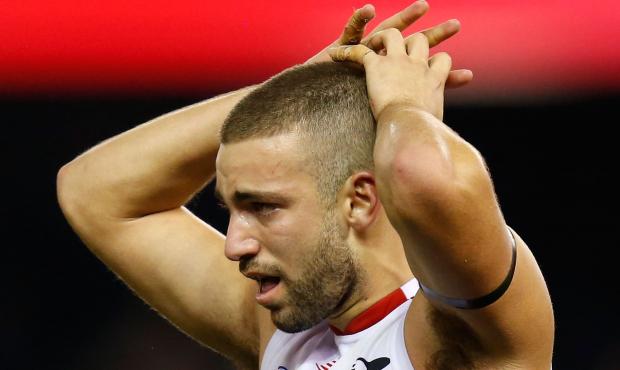MELBOURNE was woeful against Carlton on Sunday.
It was, quite simply, an appalling performance, probably the club's worst for the season. It has die-hard Demons fans wondering whether the club has regressed under Paul Roos.
That it happened against the previously bottom-placed side emphasised where the Demons are placed.
They failed to hit the most basic of targets. But most damning of all, the players appeared not to care. Harsh? Perhaps, but Roos said as much last week when he noted his players might have already been looking ahead to their end-of-season trips.
Granted, the average age of Melbourne's team on Sunday was 24 years and 143 days, which included 10 players with fewer than 50 games to their names.
But Melbourne laid just two tackles in the first 20 minutes of the game and ended the day with 56.
It allowed 10 goals to two in the opening half, just a week after it gave up the first 12 goals in a 98-point loss to the Western Bulldogs.
The Demons have lost four of their past five games by a combined 193 points, with the 37-point win over Collingwood in round 18 feeling like an age ago.
It's time to ask, has Melbourne actually improved on Roos' watch?
The slight improvements
Melbourne has won six games in 2015, two more than last year with two games to come, against Fremantle and Greater Western Sydney.
The Demons have averaged 70.8 points from their 20 games in 2015, 10 points better than last year.
The two staples of Melbourne's game style under Roos are winning contested ball and pressuring the opposition.
Roos offended by emails questioning his commitment
Based on those indicators, the Demons have made some progress.
Melbourne is averaging 135.7 contested possessions per game this season, a leap from the 130.2 it averaged in 2014 and the 123.7 it averaged before Roos took over in 2013.
The Demons thrived in this area when they beat the Bulldogs in round eight, Geelong in round 12 and the Magpies in round 18.
The Demons were plus-16 against the Dogs, plus-27 against the Cats and plus-16 against the Pies, still the competition benchmark in this area.
But the problem with playing such a combative game style is that sustaining the required effort and intensity can lead to dramatic drop-offs. Against Carlton, the Demons were minus-five in this area.
While its scoring power has increased, Melbourne still overuses the ball through the middle of the ground which, one opposition scout told AFL.com.au, messes up the Demons’ mid-forward connection.
The Demons average 33.2 disposals per goal. In contrast, the Hawks average just 24 disposals to split the big sticks.
The Demons still rely on too few, for too much
It was no coincidence that Nathan Jones and Bernie Vince were held in check in the loss to the Blues on Sunday.
When Jones and Vince perform, the Demons are an infinitely better team, but there are still too many players that go missing when challenged.
But there is support, albeit from top-end, but still-green talent, Jesse Hogan (20) and Angus Brayshaw (19), who are in their second and first years of football.
Hogan's mix of competitiveness and raw talent makes him a genuine star, while Brayshaw, pick No.3 in last year's draft, has often put his more experienced teammates to shame with his aggressive attack on the ball and the man.
The Demons think fellow top-pick Christian Petracca (No.2 overall) will be an A-grader but a ruptured ACL in his left knee in February was a major setback.
Dom Tyson and Christian Salem are elite decision-makers with the polish the Demons have lacked in recent seasons.
Max Gawn's emergence as the club's No.1 ruckman has given the Demons stability through the middle of the ground, while Tom McDonald has gone to the next level as the club's best defender.
Jack Viney and rookie revelation Aaron vandenBerg are bulls at the contest and add to the club's improving midfield depth. Jeff Garlett has kicked 36 goals for the season, behind only Hogan's 39, and the former Blue has been a key addition.
The Demons have also missed the athletic attributes, in particular the high-end speed, that Dean Kent, Sam Frost and Jay Kennedy-Harris provided before they were injured earlier in the season.

The Demons leave the field after last weekend's loss to Carlton. Picture: AFL Media
The looming list changes
Roos has had long enough to make a call on a number of players. The Demons have made 22 list changes in the past 18 months and you can expect more this post-season.
Jordie McKenzie, Rohan Bail, Aidan Riley and Mark Jamar are likely to be jettisoned, while Jack Fitzpatrick, Cam Pedersen and Daniel Cross face nervous waits as a decision is made on their futures.
The jury is still out on whether Jimmy Toumpas is going to make the cut, while utility Jeremy Howe looks increasingly unlikely to remain at the Demons as opposition clubs chase his services.
Who needs to lift?
Experienced recruits Heritier Lumumba and Chris Dawes have helped set standards for their younger teammates, but when their on-field performances are not up to scratch serious questions need to be asked.
Lumumba has been mostly disappointing since crossing from Collingwood in last year's trade period, while Dawes has shown he is not the support act needed for Hogan up forward.
Former co-captain Jack Grimes has had stints in the VFL this season and his wayward ball use is an issue, while Jack Trengove and Jack Watts have not become the players the club hoped.
The hunt for an A-grade midfielder
As good as Jones and Vince have been for much of this year, the Demons still desperately lack a top-line midfielder.
The club was prepared to offer either picks No.2 or No.3 for Adelaide's Patrick Dangerfield, but discussions between the Crows and Demons never reached official levels.
The Demons have been linked to Gold Coast's Dion Prestia, not quite in the Dangerfield mould but certainly an upgrade on their current stocks.
Expect them to be bold in search of genuine midfield talent and to be active in this year's trade period.
The areas that need fixing
Melbourne is incapable of playing four quarters of football, with the gap between its best and worst as wide as the Grand Canyon.
When the game is not played on its terms, the problems are compounded.
The players still struggle to make decisions on the fly and they rely too heavily on the coaches' instructions before acting on the field, which explains why the Demons often fail to wrest the momentum away from their opponents.
Their turnovers are costly and often come at inopportune times and when they are up against it they start playing as individuals and not as a team.
But most worryingly, they are competitive one week and uncompetitive, in their actions and mindsets, the next.
Where to from here?
If a run of losses like the ones that have happened in the past fortnight occurred a couple of years back, the club would have gone into crisis control.
But under the leadership of CEO Peter Jackson, president Glen Bartlett and Roos, the club has stability and will not be altered from the course it’s set upon.
In a bold plan announced at the club's annual general meeting in February, Jackson told club members that the club's aim was to make the finals by 2016.
By the end of next year Roos' tenure as coach will have finished, with Simon Goodwin to take the reins the following year.
The Demons have not made the finals since 2006 and based on this year's performances, it’s difficult to see them doing so by the end of next year.

Will Jimmy Toumpas make the grade for the Demons? Picture: AFL Media.


